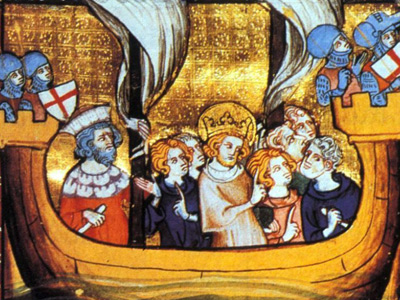Seventh Crusade (1248–1254)
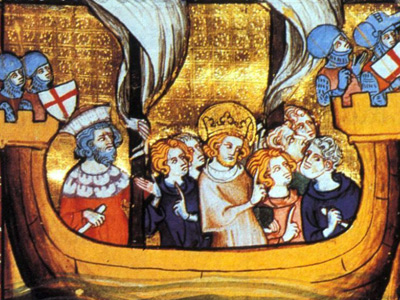
The Seventh Crusade was a crusade led by Louis IX of France from 1248 to 1254. His troops were defeated by the Egyptian army led by the Ayyubid Sultan Turanshah supported by the Bahariyya Mamluks led by Faris ad-Din Aktai, Baibars al-Bunduqdari, Qutuz, Aybak and Qalawun and Louis was captured. Approximately 800,000 bezants were paid in ransom for his return.
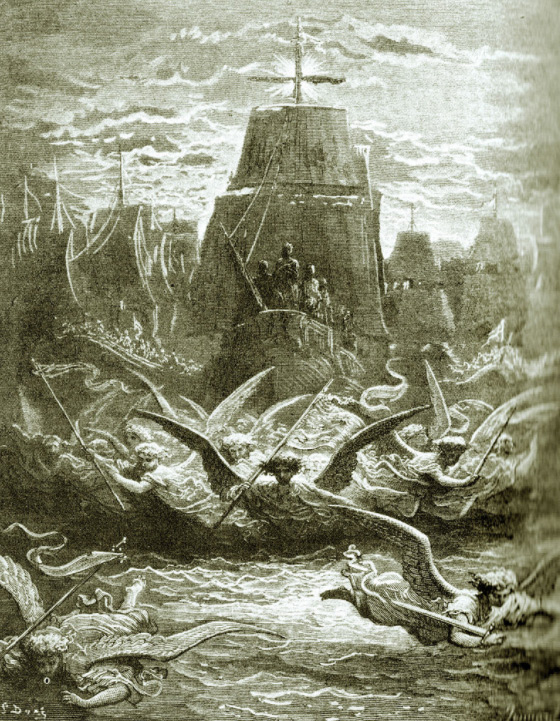
Background
In 1244, the Khwarezmians, recently displaced by the advance of the Mongols, took Jerusalem on their way to ally with the Egyptian Mamluks. This returned Jerusalem to Muslim control, but the fall of Jerusalem was no longer an earth-shattering event to European Christians, who had seen the city pass from Christian to Muslim control numerous times in the past two centuries. This time, despite calls from the Pope, there was no popular enthusiasm for a new crusade. There were also many conflicts within Europe that kept its leaders from embarking on the Crusade.
Pope Innocent IV and Frederick II, Holy Roman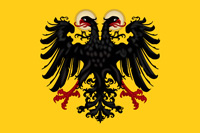 The Holy Roman Empire was a political entity in Western, Central, and Southern Europe that developed during the Early Middle Ages and continued until its dissolution in 1806 during the Napoleonic Wars. From the accession of Otto I in 962 until the twelfth century, the Empire was the most powerful monarchy in Europe. The empire reached the apex of territorial expansion and power in the mid-thirteenth century, but overextending led to partial collapse. Emperor continued the papal-imperial struggle. Frederick had captured and imprisoned clerics on their way to the First Council of Lyon, and in 1245 he was formally deposed by Innocent IV. Pope Gregory IX had also earlier offered King Louis' brother, count Robert of Artois, the German throne, but Louis had refused. Thus, the Holy Roman Emperor was in no position to crusade. Béla IV of Hungary was rebuilding his kingdom from the ashes after the devastating Mongol invasion of 1241. Henry III of England
The Holy Roman Empire was a political entity in Western, Central, and Southern Europe that developed during the Early Middle Ages and continued until its dissolution in 1806 during the Napoleonic Wars. From the accession of Otto I in 962 until the twelfth century, the Empire was the most powerful monarchy in Europe. The empire reached the apex of territorial expansion and power in the mid-thirteenth century, but overextending led to partial collapse. Emperor continued the papal-imperial struggle. Frederick had captured and imprisoned clerics on their way to the First Council of Lyon, and in 1245 he was formally deposed by Innocent IV. Pope Gregory IX had also earlier offered King Louis' brother, count Robert of Artois, the German throne, but Louis had refused. Thus, the Holy Roman Emperor was in no position to crusade. Béla IV of Hungary was rebuilding his kingdom from the ashes after the devastating Mongol invasion of 1241. Henry III of England The Kingdom of England was a sovereign state on the island of Great Britain from about 927, when it emerged from various Anglo-Saxon kingdoms, until 1 May 1707, when it united with Scotland to form the Kingdom of Great Britain. The Viking invasions of the 9th century upset the balance of power between the English kingdoms, and native Anglo-Saxon life in general. The English lands were unified in the 10th century in a reconquest completed by King Æthelstan in 927. was still struggling with Simon de Montfort and other problems in England. Henry and Louis were not on the best of terms, being engaged in the Capetian-Plantagenet struggle, and while Louis was away on crusade the English king signed a truce promising not to attack French lands. Louis IX had also invited King Haakon IV of Norway to crusade, sending the English chronicler Matthew Paris as an ambassador, but again was unsuccessful. The only king interested in beginning another crusade therefore was Louis IX, who declared his intent to go East in 1245. A much smaller force of Englishmen, led by William II Longespée, also took the cross.
The Kingdom of England was a sovereign state on the island of Great Britain from about 927, when it emerged from various Anglo-Saxon kingdoms, until 1 May 1707, when it united with Scotland to form the Kingdom of Great Britain. The Viking invasions of the 9th century upset the balance of power between the English kingdoms, and native Anglo-Saxon life in general. The English lands were unified in the 10th century in a reconquest completed by King Æthelstan in 927. was still struggling with Simon de Montfort and other problems in England. Henry and Louis were not on the best of terms, being engaged in the Capetian-Plantagenet struggle, and while Louis was away on crusade the English king signed a truce promising not to attack French lands. Louis IX had also invited King Haakon IV of Norway to crusade, sending the English chronicler Matthew Paris as an ambassador, but again was unsuccessful. The only king interested in beginning another crusade therefore was Louis IX, who declared his intent to go East in 1245. A much smaller force of Englishmen, led by William II Longespée, also took the cross.
Fighting
France The Kingdom of France is the historiographical name or umbrella term given to various political entities of France in the medieval and early modern period. It was one of the most powerful states in Europe since the High Middle Ages. It was also an early colonial power, with possessions around the world. Colonial conflicts with Great Britain led to the loss of much of its North American holdings by 1763. The Kingdom of France adopted a written constitution in 1791, but the Kingdom was abolished a year later and replaced with the First French Republic. was one of the strongest states in Europe at the time, as the Albigensian Crusade had brought Provence into Parisian control. Poitou was ruled by Louis IX's brother Alphonse of Poitiers, who joined him on his crusade in 1245. Another brother, Charles I of Anjou, also joined Louis. For the next three years Louis collected an ecclesiastical tenth (mostly from church tithes), and in 1248 he and his approximately 15,000-strong army that included 3,000 knights, and 5,000 crossbowmen sailed on 36 ships from the ports of Aigues-Mortes, which had been specifically built to prepare for the crusade, and Marseille. Louis IX's financial preparations for this expedition were comparatively well organized, and he was able to raise approximately 1,500,000 livres tournois. However, many nobles who joined Louis on the expedition had to borrow money from the royal treasury, and the crusade turned out to be very expensive.
The Kingdom of France is the historiographical name or umbrella term given to various political entities of France in the medieval and early modern period. It was one of the most powerful states in Europe since the High Middle Ages. It was also an early colonial power, with possessions around the world. Colonial conflicts with Great Britain led to the loss of much of its North American holdings by 1763. The Kingdom of France adopted a written constitution in 1791, but the Kingdom was abolished a year later and replaced with the First French Republic. was one of the strongest states in Europe at the time, as the Albigensian Crusade had brought Provence into Parisian control. Poitou was ruled by Louis IX's brother Alphonse of Poitiers, who joined him on his crusade in 1245. Another brother, Charles I of Anjou, also joined Louis. For the next three years Louis collected an ecclesiastical tenth (mostly from church tithes), and in 1248 he and his approximately 15,000-strong army that included 3,000 knights, and 5,000 crossbowmen sailed on 36 ships from the ports of Aigues-Mortes, which had been specifically built to prepare for the crusade, and Marseille. Louis IX's financial preparations for this expedition were comparatively well organized, and he was able to raise approximately 1,500,000 livres tournois. However, many nobles who joined Louis on the expedition had to borrow money from the royal treasury, and the crusade turned out to be very expensive.
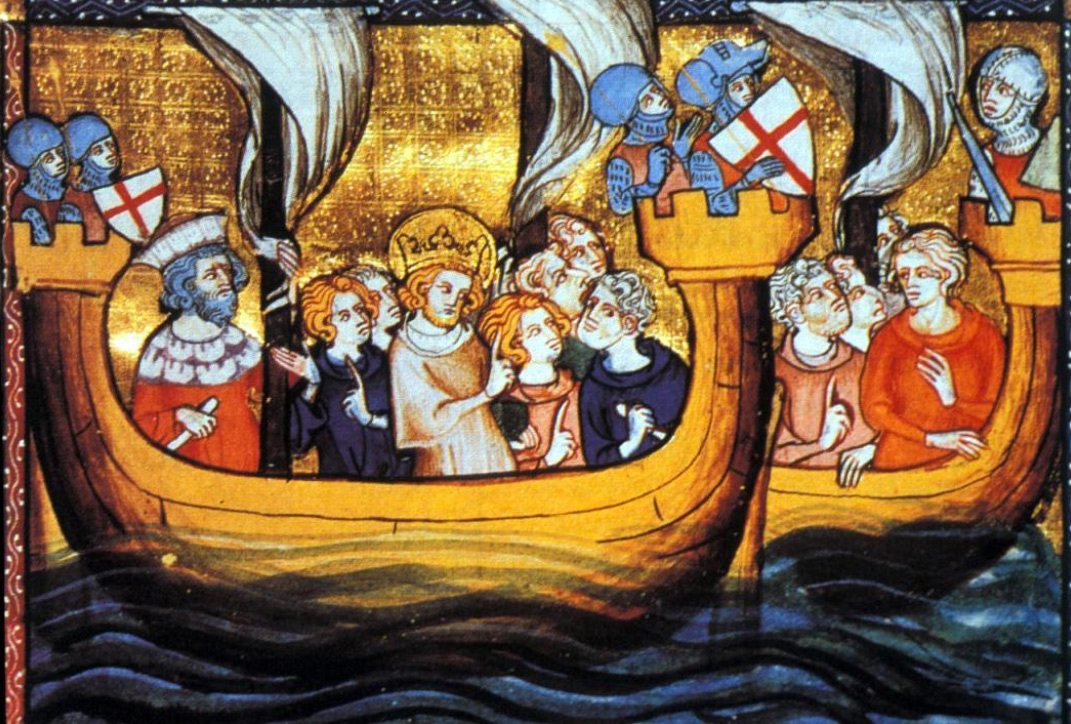
Louis IX during the Seventh Crusade

Louis IX during the Seventh Crusade
( Click image to enlarge)
They sailed first to Cyprus and spent the winter on the island, negotiating with various other powers in the east; the Latin Empire set up after the Fourth Crusade asked for his help against the Byzantine Empire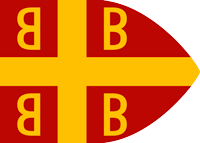 The Byzantine Empire, also referred to as the Eastern Roman Empire or Byzantium, was the continuation of the Roman Empire primarily in its eastern provinces during Late Antiquity and the Middle Ages, when its capital city was Constantinople. It survived the fragmentation and fall of the Western Roman Empire in the 5th century AD and continued to exist for an additional thousand years until the fall of Constantinople to the Ottoman Empire in 1453. of Nicaea, and the Principality of Antioch and the Knights Templar wanted his help in Syria, where the Muslims had recently captured Sidon.
The Byzantine Empire, also referred to as the Eastern Roman Empire or Byzantium, was the continuation of the Roman Empire primarily in its eastern provinces during Late Antiquity and the Middle Ages, when its capital city was Constantinople. It survived the fragmentation and fall of the Western Roman Empire in the 5th century AD and continued to exist for an additional thousand years until the fall of Constantinople to the Ottoman Empire in 1453. of Nicaea, and the Principality of Antioch and the Knights Templar wanted his help in Syria, where the Muslims had recently captured Sidon.
Nonetheless, Egypt was the object of his crusade, and he landed in 1249 at Damietta on the Nile. Egypt would, Louis thought, provide a base from which to attack Jerusalem, and its wealth and supply of grain would keep the crusaders fed and equipped.
On 6 June Damietta was taken with little resistance from the Egyptians, who withdrew further up the Nile. The flooding of the Nile had not been taken into account, however, and it soon grounded Louis and his army at Damietta for six months, where the knights sat back and enjoyed the spoils of war. Louis ignored the agreement made during the Fifth Crusade that Damietta should be given to the Kingdom of Jerusalem, now a rump state in Acre, but he did set up an archbishopric there (under the authority of the Latin Patriarch of Jerusalem) and used the city as a base to direct military operations against the Muslims of Syria. The fifteenth century Muslim historian al-Maqrizi recorded Louis IX as sending a letter to as-Salih Ayyub that said:
As you know that I am the ruler of the Christian nation I do know you are the ruler of the Muhammadan nation. The people of Al-Andalus give me money and gifts while we drive them like cattle. We kill their men and we make their women widows. We take the boys and the girls as prisoners and we make houses empty. I have told you enough and I have advised you to the end, so now if you make the strongest oath to me and if you go to Christian priests and monks and if you carry kindles before my eyes as a sign of obeying the cross, all these will not persuade me from reaching you and killing you at your dearest spot on earth. If the land will be mine then it is a gift to me. If the land will be yours and you defeat me then you will have the upper hand. I have told you and I have warned you about my soldiers who obey me. They can fill open fields and mountains, their number like pebbles. They will be sent to you with swords of destruction.
In November, Louis marched towards Cairo, and almost at the same time, the Ayyubid sultan of Egypt, as-Salih Ayyub, died. A force led by Robert of Artois, alongside the Templars and the English contingent led by William II Longespée, attacked the Egyptian camp at Gideila and advanced to Al Mansurah where they were defeated at the Battle of Al Mansurah. Robert and William were killed, and only a small handful survived. Meanwhile, Louis' main force was attacked by the Mameluk Baibars, the commander of the army and a future sultan himself. Louis was defeated as well, but he did not withdraw to Damietta for months, preferring to besiege Mansourah, which ended in starvation and death for the crusaders rather than the Muslims. In showing utter agony, a Templar knight lamented:
Rage and sorrow are seated in my heart...so firmly that I scarce dare to stay alive. It seems that God wishes to support the Turks to our loss...ah, lord God...alas, the realm of the East has lost so much that it will never be able to rise up again. They will make a Mosque of Holy Mary's convent, and since the theft pleases her Son, who should weep at this, we are forced to comply as well...Anyone who wishes to fight the Turks is mad, for Jesus Christ does not fight them any more. They have conquered, they will conquer. For every day they drive us down, knowing that God, who was awake, sleeps now, and Muhammad waxes powerful.
In March 1250 Louis finally tried to return to Damietta, but he was taken captive at the Battle of Fariskur where his army was annihilated. Louis fell ill with dysentery, and was cured by an Arab physician. In May he was ransomed for 800,000 bezants, half of which was to be paid before the King left Egypt, with Damietta also being surrendered as a term in the agreement. Upon this, he immediately left Egypt for Acre, one of few remaining crusader possessions in Syria.
Aftermath
Louis made an alliance with the Mamluks, who at the time were rivals of the Sultan of Damascus, and from his new base in Acre began to rebuild the other crusader cities, particularly Jaffa and Saida. Although the Kingdom of Cyprus claimed authority there, Louis was the de facto ruler. In 1254 Louis' money ran out, and his presence was needed in France where his mother and regent Blanche of Castile had recently died. Before leaving he established a standing French garrison at Acre, the capital of the Kingdom of Jerusalem after the loss of Jerusalem, at the expense of the French crown; it remained there until the fall of Acre in 1291. His crusade was a failure, but he was considered a saint by many, and his fame gave him an even greater authority in Europe than the Holy Roman Emperor. In 1270 he attempted another crusade, though it too would end in failure.
HISTORY
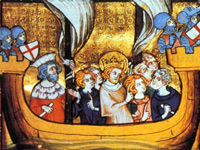
RESOURCES
This article uses material from the Wikipedia article "Seventh Crusade (1248–1254)", which is released under the Creative Commons Attribution-Share-Alike License 3.0.
© Stories Preschool. All Rights Reserved.
